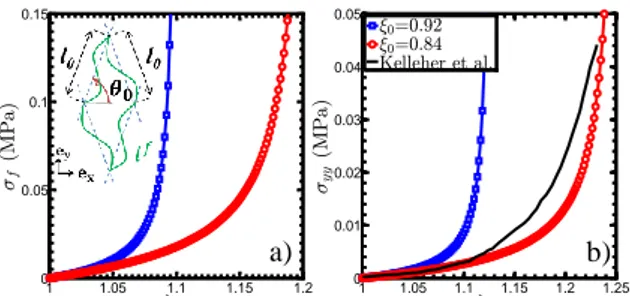HAL Id: hal-01419743
https://hal.archives-ouvertes.fr/hal-01419743
Submitted on 5 Jan 2017
HAL is a multi-disciplinary open access
archive for the deposit and dissemination of
sci-entific research documents, whether they are
pub-lished or not. The documents may come from
teaching and research institutions in France or
abroad, or from public or private research centers.
L’archive ouverte pluridisciplinaire HAL, est
destinée au dépôt et à la diffusion de documents
scientifiques de niveau recherche, publiés ou non,
émanant des établissements d’enseignement et de
recherche français ou étrangers, des laboratoires
publics ou privés.
A micro-mechanical model of the vocal-fold upper layers
Thibaud Cochereau, Lucie Bailly, Laurent Orgéas, Nathalie Henrich
Bernardoni, Philippe Chaffanjon
To cite this version:
Thibaud Cochereau, Lucie Bailly, Laurent Orgéas, Nathalie Henrich Bernardoni, Philippe Chaffanjon.
A micro-mechanical model of the vocal-fold upper layers. 22nd Congress of the European Society of
Biomechanics, European Society of Biomechanics, Jul 2016, Lyon, France. �hal-01419743�
22nd Congress of the European Society of Biomechanics, July 10 - 13, 2016, Lyon, France
A MICRO-MECHANICAL MODEL OF THE VOCAL-FOLD UPPER LAYERS
Thibaud Cochereau(1,2,3,4), Lucie Bailly(1,2), Laurent Orgéas(1,2), Nathalie Henrich Bernardoni(3,4), Philippe Chaffanjon(3,4,5)
1. Univ. Grenoble Alpes, 3SR Lab, F-38000, Grenoble, France; 2. CNRS, 3SR Lab, F-38000, Grenoble, France; 3. Univ. Grenoble Alpes, GIPSA-lab, F-38000, Grenoble, France; 4. CNRS, GIPSA-lab, F-38000,
Grenoble, France; 5. Univ.Grenoble Alpes, LADAF, F-38000, Grenoble, France
Introduction
The vocal folds are soft multi-layered laryngeal tissues, owning remarkable vibro-mechanical performances. Composed of collagen and elastin microfibrils’ networks, the upper layers play a major role in the vocal-fold vibrations. However, the impact of these tissues’ histological features on their mechanical behavior is still poorly known. This is mainly ascribed to their challenging experimental characterization: vocal folds together with their fibrous architectures are not easily observable in vivo; ex vivo mechanical tests are rare and complex to interpret [1]. Consequently, most of the vocal-fold mechanical models developed so far rely on phenomenological macroscopic approaches, roughly assuming a homogeneous vocal tissue with linear-elastic properties. Since 2010, a few authors have started to investigate and model the vocal-tissue collagenous fibrous microstructure, opening a new insight into voice biomechanics [2]. Theoretical formulations at the fiber scale still need to be developed. Thereby, this study aims at: (i) proposing an idealized but relevant model of the fibrous architecture of the vocal-fold upper layers; (ii) building a mechanical model able to predict the layers’ multiscale properties from the above idealized architectures; (iii) assessing its relevance by comparison with a reference tensile database.
Methods
Idealization of the layer fibrous architectures – The vocal-fold upper layers can be seen as a 3D composite structure made of a soft isotropic hyperelastic matrix, reinforced by a periodic network of bundles of wavy collagen fibrils displaying preferred orientations. This fibrous architecture is idealized by the Representative Elementary Cell (REC) shown in Fig.1(a). Most of the REC parameters can be extracted from existing histological data [1,2,4]: fibril diameter (𝑑0≈ 0.1 µm)
and length 𝑙𝑓, initial tortuosity (𝜉
0≈ 0.84; 0.92) and
lattice length (𝑙0≈ 𝜉0𝑙𝑓 ≈ 20; 30 µm), collagen fibrils
content (𝜙 ≈ 0.15), initial orientation of fibril bundles (𝜃0≈ 67.5°) with respect to vocal-fold main direction.
Multiscale model – To determine the macroscale mechanical response of the as-idealized upper layers under simple uniaxial tensile loading, a non-linear and anisotropic multiscale model is proposed. This theoretical model is written using the homogenization method for periodic discrete structures, as already applied to the context of vascular biomechanics [3]. For that purpose, attention is paid to build a relevant micromechanical model describing the unfolding and
the tensile deformation of wavy collagen fibrils, accounting for their elastic properties [4, 5].
Results and discussion
The prediction of collagen fibrils’ tensile behavior (𝜎𝑓, 𝜆𝑓) is plotted in Fig.1(a) for two typical fibril
tortuosities: 𝜉0≈ 0.84; 0.92 [2]. Unfolding the fibrils
conducts to typical J-shaped stress-elongation curves depending on 𝜉0. Once the fibril unfolded, curves show
a linear evolution with a tangent modulus of 1 GPa [4].
Figure 1: Stress-elongation curves for tensile tests
along ey: (a) model predictions for the fibril (b) model
predictions and experimental data for the tissue.
The macroscale predictions of the multiscale model are given by the stress-elongation curves plotted in Fig.1(b) for the same 𝜉0 values. The mechanical
behavior of the vocal ligament under tension is also illustrated in Fig.1(b), as an experimental reference recently reported using DIC measurements [1]. As observed at the microscale in Fig.1(a), both macroscale curves exhibit a J-shaped non-linear mechanical behavior, characteristic of collagenous soft tissues. Fig.1(b) also demonstrates a fairly good quantitative agreement with the reference mechanical data, keeping in mind that all model parameters derived from histological evidences. Further used to simulate in vivo loadings, this model will help to understand the role of the fibrous networks in vocal-fold vibratory properties. It will also provide proper guidelines to design new composites mimicking vocal-fold biomechanics.
References
1. Kelleher et al, J. Acoust. Soc. Am., 133:1625-1636, 2013. 2. Miri et al, Laryngoscope, 122:356–363, 2012.
3. Bailly et al, JMBBM, 10:151-165, 2012. 4. Yang, PhD Thesis, 2008.
5. Kabla and Mahadevan, JRSI, 4:99-109, 2007.
Acknowledgements
This work is supported by the Labex Tec21 (Investissements d’Avenir - grant agreement ANR-11-LABX-0030).
1 1.05 1.1 1.15 1.2 0 0.05 0.1 0.15 6f <f (M P a ) 1 1.05 1.1 1.15 1.2 1.25 0 0.01 0.02 0.03 0.04 0.05 6yy <y y (M P a ) 90=0.92 90=0.84 Kelleher et al. a) b)
